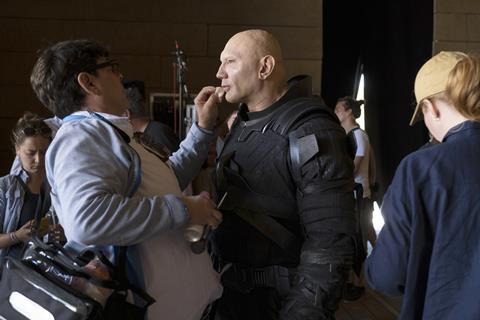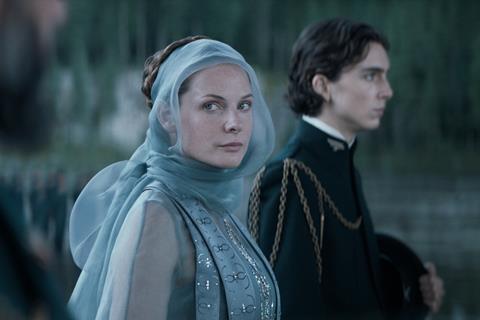Sci-fi adventure Dune showcases notable work across the craft departments — and especially in the case of hair and make‑up. Department head Donald Mowat tells Screen how they made an impact while staying rooted in reality.

Director Denis Villeneuve was not the only one who cast his eye over the phalanxes of Harkonnen and Sardaukar troops to ensure every individual that populates his otherworldly sci-fi Dune looked just right.
It fell on Donald Mowat, the hair designer and make-up specialist who has worked on several of Villeneuve’s films, to ensure no ringlet, skin tone, blemish or tribal marking was out of place on the Legendary/Warner Bros tentpole.
“Denis likes things to be based in reality, which I respond to very well,” says Mowat, Dune’s hair and make-up department head who worked with the French-Canadian filmmaker on Blade Runner 2049, Prisoners and Sicario, and considers it a job well done if audiences buy into his work without getting too curious about its mechanics.
On set he divvied up assignments for his team and personally oversaw make-up for lead cast members Rebecca Ferguson as Lady Jessica, Timothée Chalamet as her son Paul Atreides in whose callow hands lies the future of the universe, Josh Brolin as House of Atreides weapons master Gurney Halleck, and Dave Bautista as Rabban, an imposing warmonger whose physicality is outdone only by his uncle, Stellan Skarsgard’s scheming, intimidating Baron Harkonnen.
Long before principal photography got underway in Budapest in spring 2019 (Dune also filmed in Norway, Jordan and the United Arab Emirates), Mowat was in deep discussions with Villeneuve to create the look. Like his director, Mowat avoided rewatching David Lynch’s largely panned 1984 feature adaptation or the 2000 television series so as not to be unduly influenced by other people’s visions. “I learned on Blade Runner [2049] not to do that. You need something fresh, your own ideas.”
Of course, he had read author Frank Herbert’s book and admits he could not resist just a peek here and there at scenes in Lynch’s film. “I wanted to see what I was up against. It was terrifying. They had red hair! It was like looking at The Rocky Horror Picture Show. At that time, they were doing something unique and it was great, and now we’re in a different time and we’re doing something differently.”
Mowat created mood boards for each character and in the case of the Baron he referenced Cardinal Richelieu and Marlon Brando, in particular the actor’s pallid complexion in the ill-fated 1996 sci-fi horror The Island Of Dr. Moreau. “You also show what you don’t want, so someone has a visual reference of Matt Lucas from Little Britain, even though it’s brilliant work, or Mike Myers as Fat Bastard in the Austin Powers films.”
Form and function
The goal was to use practical make-up and not predominantly effects to bring the characters of Dune to life. Villeneuve liked what he saw, and after Mowat and longtime prosthetic design collaborator Love Larson — “he sculpted a great nose for me for Jared Leto in The Little Things” — had played around with sketches and Photoshop, the director signed off the mood boards. Sweden’s Larson and his partner Eva von Bahr in Stockholm built the silicone prosthetic face pieces and fat suit that would house Skarsgard.
The work was intricate, and Mowat was grateful to have ample time to prepare beyond what he calls the “typical two or three weeks”.
“A lot of people think we have the same prep time as costume and art departments, and we don’t… [but] Denis likes me to be in early on prep and that started probably with Blade Runner 2049. On Dune there were make-up applications at the end of the schedule that needed 16 or 17 weeks of prep to be ready. You can’t come up with something the day before, but we often do.”
Skarsgard filmed about seven days towards the end of principal photography and would spend anywhere from four to six hours in the make-up chair. It was physically demanding work. The prosthetics and fat suit weighed more than 80 pounds and the 6ft 3in, 70-year-old Swedish star wore a cooling vest underneath the costume, which meant a crew member was always a few feet away holding a portable air conditioner.
The Baron got around. He would be rigged for scenes when he floats eerily and the production hired a stunt double who was flown to Stockholm for a fitting of his own suit.
Mowat recalls the sequence where the Baron emerges from a giant tub of oily black liquid as being one of the most logistically challenging of his career. Tests were done to make sure the liquid would not stain the costume or spoil the make-up. Five artists worked on Skarsgard, whose suit now had slits cut in it to hold the actor and prevent him from slipping under, as well as two background actors in the scene who needed full make-up.

Ferguson and Chalamet were also on set that day. In general, Mowat says the creative goal with Ferguson was to show she could be 17 or 18 years older than Chalamet’s young scion and still look radiant. Light make-up applications were the order of the day. “I wanted her to be made up in a way that was beautiful, quite ethereal but also believable as the mother,” he says.
When production relocated to Jordan for most of the scenes on the desert planet Arrakis, whose sand dunes contain unique properties that are coveted by the Baron, Mowat recalls being “terrified” Ferguson and Chalamet might freckle. “They had to stay out of the sun,” he says. “It made me think of how they kept Holly Hunter and Anna Paquin so pale in The Piano. Timmy and Rebecca were both incredibly respectful and knew if they got tanned or sunburned it would be problematic for us in matching their make-up [to earlier scenes].”
Mowat’s team needed a few extra pairs of hands to cover Bautista’s tattoos and apply “tricky” prosthetic eyebrow covers, which resulted in an “eerily beautiful” look that had a Mephisto element, as Villeneuve put it. The goal was to keep things relatively understated and believable, much like the “undetectable” work of one of Mowat’s professional inspirations, the make-up artist Ann Brodie on Barry Lyndon.
With Brolin, the challenge was to create a “vine-like scar” on the warrior’s face. The description would be familiar to die-hard Dune fans, and Mowat wondered if Brolin, with his considerable experience of action tentpoles, might request a prosthetic make-up specialist. Mowat need not have worried. He opted not to mimic the original film and asked his Stockholm associate Larson to sculpt a subtle scar. Brolin approved.
Mowat, who was born in Quebec to British parents and later became a naturalised US citizen, began his career in the mid-1980s, amassing credits including The Fighter and Daniel Craig vehicles Spectre, Skyfall and The Girl With The Dragon Tattoo. But despite that long professional career, Mowat was overwhelmed on watching Dune for the first time alongside the entire cast at the world premiere in Venice last year. The company’s hard work paid off handsomely, and earned a seven-minute standing ovation.
“I didn’t expect to be there because we’re never invited to all that stuff,” he says. “When the film was over, I was so moved for Denis because this was his childhood dream. I knew it was really good. I even skipped the dinner, I was so exhausted.”






![The Brightest SunScreen[Courtesy HKIFF]](https://d1nslcd7m2225b.cloudfront.net/Pictures/274x183/3/5/0/1448350_thebrightestsunscreencourtesyhkiff_312678.jpg)


















No comments yet